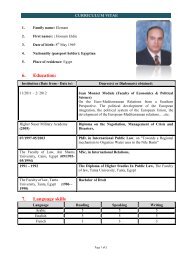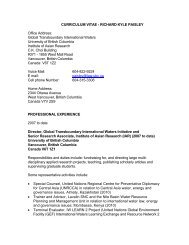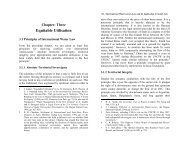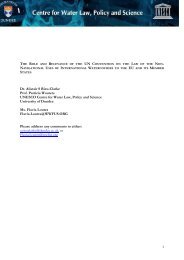Upreti, Trilochan, International Watercourses Law and Its Application ...
Upreti, Trilochan, International Watercourses Law and Its Application ...
Upreti, Trilochan, International Watercourses Law and Its Application ...
Create successful ePaper yourself
Turn your PDF publications into a flip-book with our unique Google optimized e-Paper software.
88 / <strong>International</strong> <strong>Watercourses</strong> <strong>Law</strong> <strong>and</strong> <strong>Its</strong> <strong>Application</strong> in South Asia Development <strong>and</strong> Codification of <strong>International</strong> <strong>Watercourses</strong> <strong>Law</strong> / 89either side to the injury of health or property on the other'. 189This treaty has explicitly prohibited transfrontier harm, butthese provisions did not work at all. As a result, to reverse <strong>and</strong>avert this harm these states negotiated another treaty which wasbased on Article IV (based on no harm rule) of Boundary WaterTreaty 1909. But from the time of the treaty until 1992, theboundary waters of the Great Lakes were seriously pollutedeven after the conclusion of the new treaty. The Great LakesWater Quality Agreement, 1972 (revised 1978) was an attemptto reverse the degree of pollution. 190 So it is one of the bestexamples of the failure of the no appreciable harm principle (inArticle IV of the said treaty). 191 The first of these Treatiesbased on the no harm rule did not work at all, <strong>and</strong> has becomethe foremost example of the limitation of that rule. The twosubsequent Treaties have relied heavily on transboundarycooperation to achieve success. Also, another example of theproblematic application of this rule was on the Flathead Rivercase in which a company proposed to establish a coal mine onCabin Creek. Objected to by the US <strong>and</strong> Canadiangovernments, the subject fell under the <strong>International</strong> JointCommission (IJC) according to the boundary Waters treaty.The IJC, in its recommendation explicitly indicates that thesubject in question could irreversibly make an adverse impacton the fish population. Consequently, the establishment of acoal mine would be against Article IV of the said treaty. Theappreciable harm used by the IJC in this case, it could beargued, would come under the equitable <strong>and</strong> reasonableutilisation concept, which may be politically <strong>and</strong> legallyunacceptable to upstream states because it resurrects thedoctrine of prior appropriation. 192As a result of the above, equitable utilisation emerged as afundamental principle of IWL that protects the interests of all.189 Supra note 65.190 Ibid.191 Ibid. pp. 88-89.192 Ibid. p. 92.According to McCaffrey, 193 in the contexts of Ethiopia <strong>and</strong>Nepal, if the downstream states are authorised to have a veto asdemonstrated above, upstream states could never develop anywater project within their own territories; <strong>and</strong> this would meanextreme injustice to them. In this sense, India cannot object toNepal carrying out new water projects.The ILC has also addressed the question of non-discrimination.From the point of the Trail Smelter case, extraterritorialpollution impacts upon the US <strong>and</strong> Canada, which have beendealt with using the concept of non-discrimination. 194 Nodiscriminationrefers to the principle that a citizen of eithercountry may take action in national courts to combatexterritorial pollution. In this context, the drafting committeehad forwarded to the full commission for its consideration thearticle titled Non-Discrimination Clause, "recourse underdomestic law.” The non-discrimination clause triggeredcriticism from some of the members, who had objected to it,stating that it is, in fact, wrong to include a provision grantingsuch broad rights to foreign nationals or judicial persons,regardless of their place of residence. Main purpose of theArticle was to regulate relations between states in an areainvolving the interests of a large numbers of states, <strong>and</strong> inpractical terms it will be impossible to give the same service toa foreigner as to its own citizens. 195 The ILC was not preparedto keep the non-discrimination clause, which was severelycriticised. 196 However, it has been incorporated in the UNGAdeliberation. Nonetheless, such an arrangement on nondiscriminationis working satisfactorily without any difficultiesin Norway-Sweden <strong>and</strong> Finl<strong>and</strong>. 197 The reason is that they193 Supra note 181, p. 509.194 Supra note 169, pp. 17-29.195 II (1) YBILC (1994), p. 189.196 Ibid. p. 27.197 Supra note 151, pp. 449-463: Sweden <strong>and</strong> Finl<strong>and</strong> have similar legalsystems <strong>and</strong> citizens of either country can lodge judicial <strong>and</strong>administrative complain in either country in the event of transboundarypollution or any adverse affects.












